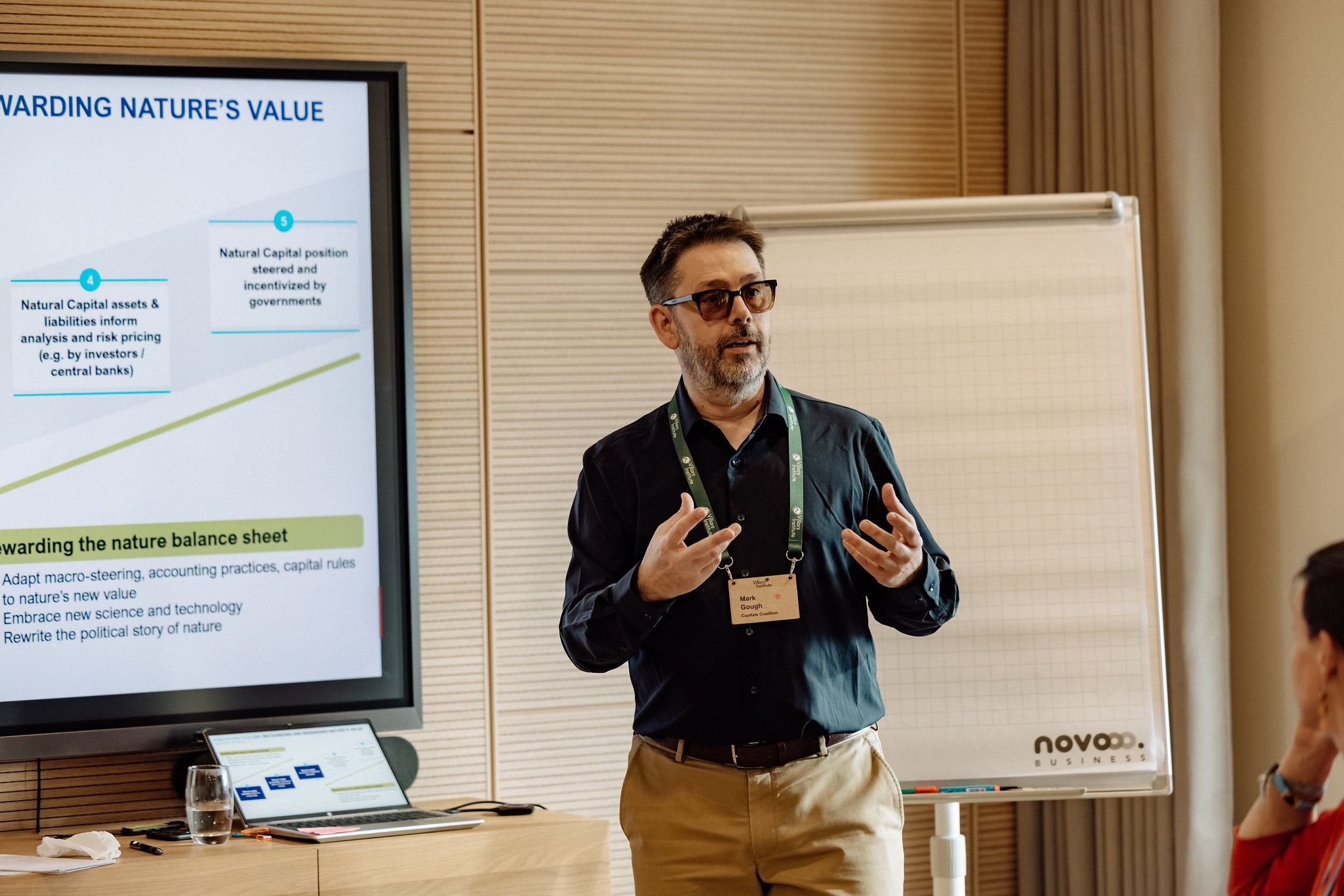Ideas from the Speakers
The session enabled a productive discussion on one of the key challenges in the net-zero, nature-positive transition: valuing the natural environment and global commons in our economic system. In simple terms, experts argue that our current way of producing and consuming products has negative effects on society and nature (what economists refer to as externalities), and that the price of goods and services does not actually reflect the cost of this damage. Among the ways to address this involves efforts to incorporate externalities on corporate financial balance sheets, representing them as liabilities if the effect is negative, or as assets should the effect be positive. In the context of nature, incorporating this on the balance sheet makes pursuing a net nature-positive approach an obvious choice since it assigns monetary value that our economic system values. Concerningly enough, as per one expert, only about 7% of companies have performed an assessment on natural capital (including roughly 25% of the S&P 500).
The speakers shared a document they compiled, titled “The Roadmap for Putting Nature on the Balance Sheet,” the result of a discussion at last year’s Villars Institute Summit. All the speakers placed significant emphasis on this paper, which describes some of the key challenges to putting nature on the balance sheet: current efforts are siloed, slow in pace, and susceptible to disruption. More concretely, a lack of clarity exists on how nature capital should affect corporate decision-making, and mobilizing actors and engaging the right stakeholders are challenging. The question of how to derive financial value from nature capital remains, and there appears to be a shortage of clear, proven models to follow.
The primary goal of this session was to share the progress made with the creation of the roadmap and to engage participants to contribute and provide inputs on the initiative’s direction. An expert introduced the ideas by focusing on scientist Johan Rockström’s planetary boundaries within the context of the current economic system, which works unsustainably and outside the planet’s safe operating limits. The question was how to transform this narrative, and the conclusion was that incorporating nature on the balance sheet is one of the key tools at our disposal.
The same speaker shared the biggest breakthrough of the roadmap: a chart explaining the three main steps in the journey to fully recognizing natural capital on balance sheets. The first step is conducting an assessment based on trusted data to determine the value of natural capital for a specific entity. This is followed by an accounting process that quantifies the value of the natural capital to business and society. That value is then recognized in official financial accounts, where it is reflected as either an economic benefit or a liability. Broadly, the first steps focus on reporting the status and actions, while the later stages focus on recognizing value, incentivizing action.
The core assumption is that recognizing natural capital challenges the “business as usual” mindset by presenting natural capital as an asset, affecting both investor conversations and decisions made from the bottom up.
A speaker raised the idea that the corporate world is run by accountants who tend to be risk averse because fundamental mistakes can have significant consequences. This raises the real question of how to get compliance on their side, which became a major topic of discussion in the group.
Insights from the Audience
One question centered on how to shift from measurements to action and align this initiative with existing standards. Speakers clarified that they communicate with existing standard setters, such as the International Sustainability Standards Board and the Corporate Sustainability Reporting Directive, aligning and learning from each other.
In the breakout sessions, one group focused on accounting and developed some short- and long-term goals to pursue. Natural capital can be easily included in the notes to the financial statements section of balance sheets, allowing it to be included without immediate fiscal impact, with the long-term goal of incorporating it directly into the balance sheet. A participant noted that involving those responsible for finances in the discussion, such as chief financial officers (CFOs) and accountants, would allow them to become ambassadors for the mission. The group saw this as a point of entry for the Villars Institute, which could help convene CFOs and accountants to engage them in the discussion.
The breakout group on lawmakers and regulators reported that better laws and regulation, while often challenging to implement, can help accelerate this work, especially if initially there is a do-no-harm policy for entities that choose to voluntarily incorporate natural capital on the balance sheet. These actors can also encourage smaller-scale, sector-specific initiatives that enable meaningful action and accelerate progress by reducing bureaucracy.
A group of price setters focused on the idea of viewing healthy natural capital as a valuable asset at risk of being degraded. The focus was on the long-term cost-benefit of doing the right thing (as opposed to the well-known cost of inaction) and how this perspective should influence regulators, rating agencies, and tax policy decisions.
The group examining industry proof points focused on studies in the food and pharmaceutical sectors, many linked to Scandinavian countries where natural capital is often viewed as a shared community asset. Their discussion emphasized spatial awareness of the future and the recognition that current risks already exist.
Notably, one of the key challenges is the role-play problem, which suggests that all actors individually say they can do their part but feel that others are barriers. This highlights the nature of a systems challenge and emphasizes the need to bring the right stakeholders together to address issues holistically, breaking down silos to find the most common-sense path forward.




